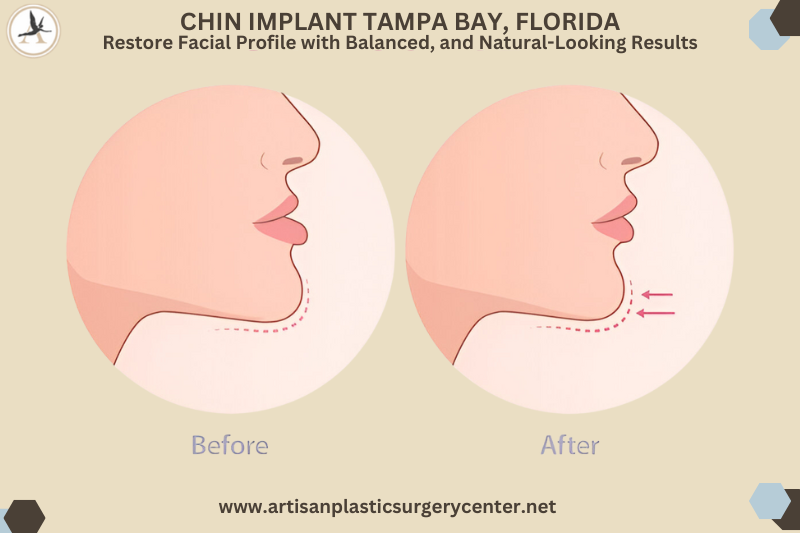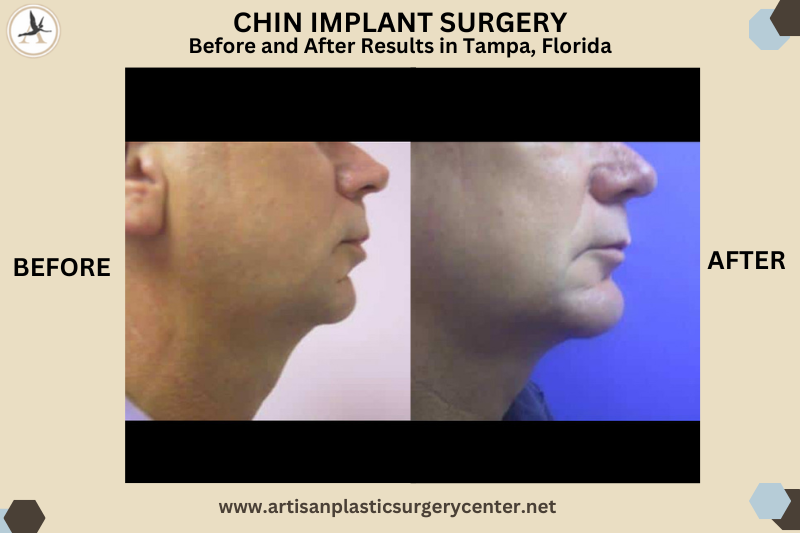Chin implant surgery is a popular procedure that offers a way to enhance the shape of the face while improving your facial contour. While creating a more balanced and attractive facial profile. This effective procedure helps individuals who feel that their chin is not in proportion with the rest of their facial features.
Improving Your Facial Contour – The Key Takeaways
Here are some key aspects to consider for improving your facial contour with a chin implant:
- A chin implant, also known as mentoplasty, is a form of facial plastic surgery.
- Particularly involves the placement of an implant around the chin bone.
- Enhance the contours of the face and improve overall facial balance.
- Knowing whether you are a good candidate for this procedure is important.
- As with most other procedures, it is recommended that you request a consultation to determine if chin implant surgery is right for you.

Chin Implant Surgery in Tampa, Florida – The Overview
Chin implant surgery aims to enhance the appearance of the chin area. The surgeon performs it in an outpatient setting under general or local anesthesia. Your surgeon will create an incision inside your mouth or directly underneath the chin.
They will then create space for the implant through the small incision and place the device. The majority of surgical procedures involving chin implants take less than an hour to complete. However, various factors can affect the time your procedure takes.
Improving Your Facial Contour – The Key Considerations
1. Assessment and Goals
a. Consultation
The first step is to consult with a qualified plastic surgeon who specializes in facial procedures. During the consultation, the surgeon will assess your facial structure, discuss your aesthetic goals, and recommend the best approach.
b. Imaging
Some surgeons might use 3D imaging technology to show you how your face might look after the surgery.
2. Types of Chin Implants
a. Material
In general, chin implants are made from medical-grade silicone or other biocompatible materials. For instance, Gore-Tex or Medpor.
b. Durability
Chin implants are designed to be permanent. However, future surgeries might be required to adjust or replace the implant due to aging or other factors.
c. Shape and Size
To emphasize, implants come in various shapes and sizes. However, the choice depends on the desired outcome and the natural anatomy of your jaw.
3. The Procedure
a. Anesthesia
The surgeon performs chin implant surgery usually under general anesthesia or local anesthesia with sedation.
b. Incision
Then, he may choose to make the incision. Either underneath the chin (submental incision) or inside the mouth along the lower gum line (intraoral incision).
c. Placement
Later, the surgeon places the implant around the chin bone. Subsequently, adjust it to the correct position to achieve the desired aesthetic effect.
d. Closure
Lastly, close the incision with sutures and cover the treated area with bandages.
4. Risks and Considerations
a. Aging
Unquestionably, aging might affect your facial features and how the implant will integrate with these changes over time.
b. Complications
Problems could happen, as with any surgical procedure. However, these include getting an infection and the implant moving out of place. Also, a bad reaction to the anesthesia during surgery.
c. Outcomes
Individuals should have realistic expectations. While the surgery can enhance facial harmony. Therefore, it is important to understand that it alters your natural facial appearance.
5. Cost and Insurance
a. Expense
The cost of a chin implant varies depending on several factors. For instance, the surgeon’s fee, the type of implant, and the geographic location.
b. Insurance
Since chin implant surgery is considered a cosmetic treatment. Thus, it is typically not covered by health insurance.
Improving Your Facial Contour – Chin Implant Surgery Recovery
Generally, recovery requires one to two weeks. Although some individuals may have swelling and bruising. Regardless, they are common and usually subside within a few weeks.
1. Downtime
After a successful implant surgery, you can expect to be able to return to most daily activities after one week. However, you may have to use cold compresses and medication to control pain and discomfort. After three to four weeks, you may be able to resume strenuous activities.
2. Post-Treatment Care
Equally important, follow the surgeon’s instructions. The post-surgery recovery guide includes oral hygiene, eating, and activity restrictions to ensure proper healing. In fact, the results from chin implant surgery will not change over time. Even if your skin’s appearance and elasticity are affected by the natural aging process. Conversely, there is a slight risk that facial trauma could damage the implant.
3. Follow-up Visits
Undoubtedly, these are necessary to monitor the healing process. As well as the positioning of the implant.
Who Should Consider Chin Implant Surgery?
Basically, a chin implant can improve different aspects of your appearance. These include:
- Weak chin.
- Wide or large chin.
- Recessed chin.
- Asymmetry of the chin.
- An unbalanced facial profile.
- Excess fat deposits below the chin.
Not to mention, a chin implant can significantly enhance facial symmetry and improve self-confidence. Another key point, it’s crucial to thoroughly research and consider all aspects of the procedure. Henceforth, consult with experienced professionals and maintain realistic expectations about the outcomes.

Chin Implant Surgery – FAQs and People Also Asked
What is a chin implant surgery?
It is a cosmetic procedure that enhances the size and shape of the chin using an implant.#
Who is a suitable candidate for chin implant surgery in Tampa, Florida?
Candidates are individuals who have a weak or receding chin and desire more definition in their facial profile.
Is the chin implant surgery painful?
Local anesthesia is used during the procedure, so patients may experience some discomfort, but it is typically manageable.
What is the recovery process like after chin implant surgery in Tampa, Florida?
Swelling and bruising are common, and patients may need to follow a restricted diet for a few days. Recovery time varies but is usually around 1-2 weeks.
What are the associated risks with chin implant surgery?
As with any surgery, there are risks such as infection, implant shifting, and nerve damage. But these are rare when performed by a qualified surgeon.
How long does a chin implant surgery last?
Chin implants are designed to be permanent, but they can be removed or replaced if needed.
Can a chin implant surgery be combined with other procedures?
Yes, surgeons can combine procedures like rhinoplasty or facelifts for a more comprehensive facial enhancement.
Will the chin implant look natural?
When done by a skilled surgeon, the implant will be placed in a way that looks natural and harmonizes with the rest of your facial features.
How soon after surgery can I return to work or regular activities?
Most patients can return to work or regular activities within a week, but strenuous exercise should be avoided for a few weeks.
Can a chin implant surgery be reversed in Tampa, Florida?
Yes, the implant can be removed if the patient is unhappy with the results.
How do I choose a qualified surgeon for chin implant surgery in Tampa, Florida?
Look for a board-certified plastic surgeon with experience in facial procedures and a good reputation for achieving natural-looking results.
Can I see before and after photos of chin implant surgeries your practice has performed?
Yes, our practice has a portfolio of before-and-after photos that we are happy to share with you during your consultation.
How long does the procedure typically take?
Chin surgery is a fast procedure that usually lasts between half an hour to one hour. It’s much quicker than most other facial surgeries. Your surgeon will work efficiently to reshape your chin while you’re under anesthesia.
Will there be visible scarring after the chin implant surgery?
The surgeon creates tiny cuts in your mouth or under your chin to perform the surgery. This placement helps hide any marks from the surgery. Most people won’t notice these cuts after they heal.
How much does a chin implant surgery cost?
Chin implant surgery costs between $3000 and $5,000 in most cases. The final price depends on where you live and which doctor you choose. Some surgeons charge more based on their experience. The surgery details can also affect the total cost. You should talk to a few surgeons to compare prices in your area.
Improving Your Facial Contour – Scheduling Chin Implant Surgery Consultation in Tampa, Florida
Chin implant surgery can help transform your facial contour, improve symmetry, and create a more balanced profile. Interested in exploring the ways that a chin implant surgery can help you? Get in touch with us at Artisan Aesthetics Plastic Surgery & Laser Center. Simply dial (813) 971-2000 our team can help you schedule a consultation with Dr. Stan Castor at our Tampa, Florida, office.
Dr. Stan Castor is board-certified in plastic surgery and has extensive experience in facial cosmetic procedures. You can also review his before-and-after photos of previous patients to assess his aesthetic style and skill.

